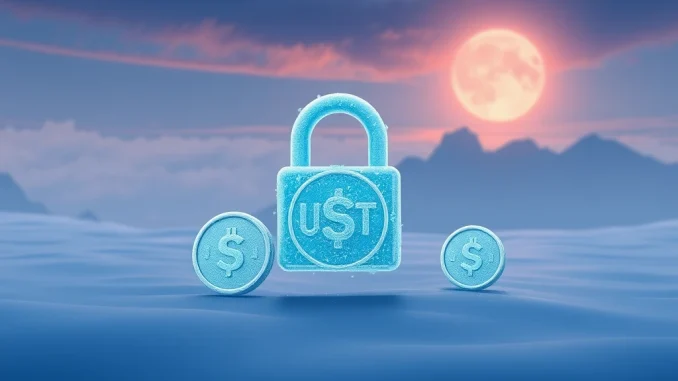
The world of stablecoins just saw a significant action demonstrating the growing intersection of traditional finance regulation and the digital asset space. Leading stablecoin issuers Tether and Circle have implemented a targeted Tether USDT freeze and Circle USDT freeze on addresses linked to a firm recently sanctioned by U.S. authorities.
Understanding the Impact of Crypto Sanctions
The action follows sanctions issued on May 29 by the U.S. Treasury’s Office of Foreign Assets Control (OFAC). OFAC is the primary body responsible for administering and enforcing U.S. economic and trade sanctions. Their recent focus has increasingly included the cryptocurrency ecosystem as illicit actors attempt to use digital assets to circumvent traditional financial controls.
Applying crypto sanctions means identifying wallets or entities associated with sanctioned individuals, groups, or countries and preventing U.S. persons and, often, entities operating under U.S. jurisdiction or handling U.S. dollar-pegged assets (like USDT and USDC), from interacting with them. This is a critical tool in combating financial crime globally.
Why Were These Specific Funds USDT Frozen?
The specific target in this instance is Funnull Technology, a computer infrastructure provider based in the Philippines. According to OFAC, Funnull is allegedly involved in ‘pig butchering’ scams. These are sophisticated, long-term fraud schemes where scammers build trust with victims over time, often through dating apps or social media, before convincing them to invest in fraudulent crypto platforms. The victims’ funds are then stolen.
Crypto tracking platform MistTrack on X identified two addresses linked to Funnull Technology that held approximately 19,955 USDT combined. Following the OFAC designation, Tether and Circle acted to freeze the funds held in these specific addresses. This prevents the sanctioned entity from moving or accessing the USDT frozen in these wallets.
How Does a Stablecoin Freeze Work in Practice?
For centralized stablecoins like USDT and USDC, issuers have the technical capability to freeze assets held in specific addresses. This is a function built into the smart contracts governing the stablecoin. When an address is added to a blacklist by the issuer (usually in response to law enforcement requests or sanctions), the smart contract prevents any outgoing transactions from that address.
Here’s a simplified breakdown:
- Authorities (like OFAC) identify addresses or entities involved in illicit activity.
- They notify stablecoin issuers (like Tether and Circle).
- The issuers add the specified addresses to an internal blacklist within their smart contract.
- Any funds held in these addresses become inaccessible and cannot be moved.
This capability, while controversial among strict decentralization advocates, is presented by issuers as a necessary measure to comply with global regulations and assist law enforcement in recovering or preventing the movement of illicit funds.
What Are the Implications of the Tether USDT Freeze and Circle USDT Freeze?
This action highlights several key points about the current state of the crypto market:
- Increased Regulatory Scrutiny: Regulators worldwide, particularly in the U.S., are actively monitoring and taking action against the use of crypto in illicit finance.
- Stablecoins as a Compliance Point: Centralized stablecoins, due to their link to fiat currencies and their issuers’ corporate structures, are often the first point of contact for regulatory enforcement in the crypto space.
- Issuer Cooperation: Tether and Circle demonstrate their commitment to complying with OFAC sanctions and other legal requirements, even if it means overriding the usual permissionless nature of blockchain transactions for specific addresses.
- Combating Scams: Freezing funds linked to scams like pig butchering can potentially prevent the perpetrators from benefiting from their illicit gains and serve as a deterrent.
While the amount frozen (approximately $20,000) might seem small in the context of the multi-billion dollar stablecoin market, the significance lies in the principle: sanctioned entities attempting to use stablecoins can have their assets frozen by the issuers in coordination with regulators.
Challenges and the Future
This situation also brings to the forefront the ongoing debate about centralization vs. decentralization in crypto. The ability of a central issuer to freeze funds is powerful for compliance but raises questions about censorship resistance and user control. As regulators continue to engage with the crypto space, stablecoin issuers will face the challenge of balancing regulatory demands with the foundational principles of blockchain technology.
Conclusion: A Clear Signal to Illicit Actors
The coordinated Tether USDT freeze and Circle USDT freeze targeting addresses linked to a sanctioned firm is a clear signal. It underscores that using major stablecoins for illicit activities, especially by entities designated by powerful regulatory bodies like OFAC, carries significant risks. Stablecoin issuers are actively working with authorities to combat financial crime, making it harder for scammers and sanctioned entities to operate within the regulated parts of the crypto ecosystem. This move reinforces the message that compliance is becoming an unavoidable aspect of the mainstream crypto world.



